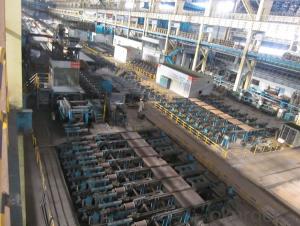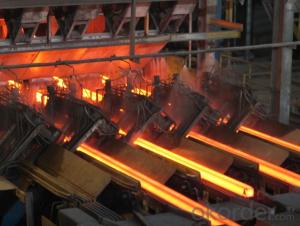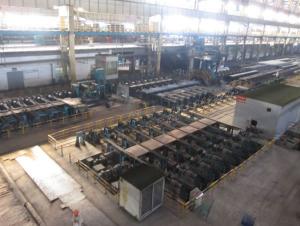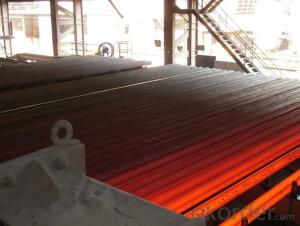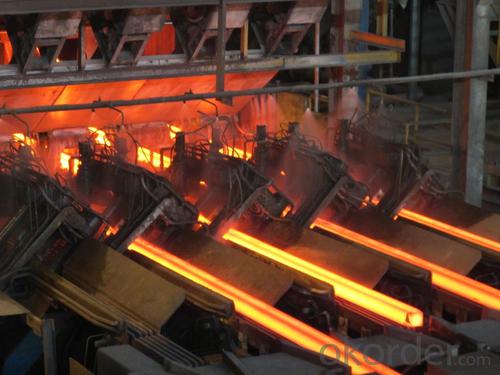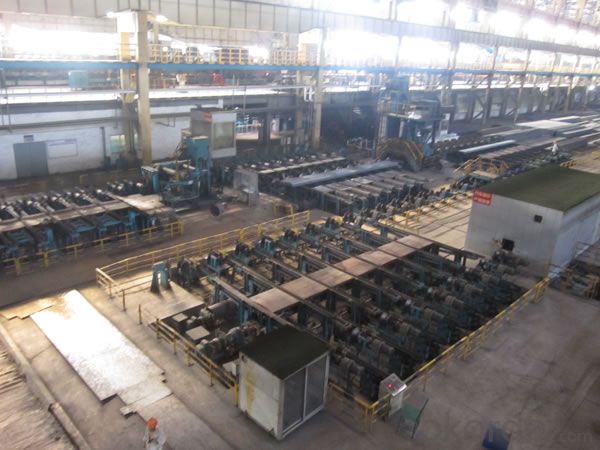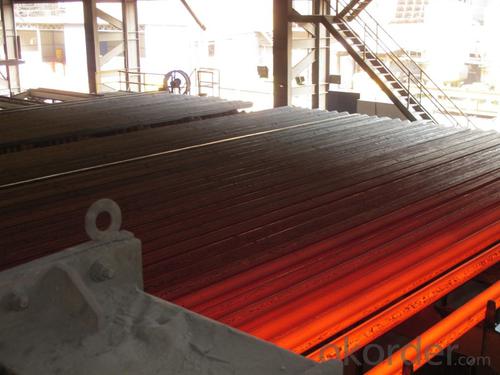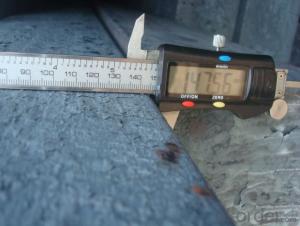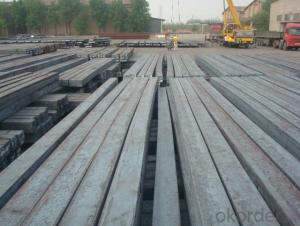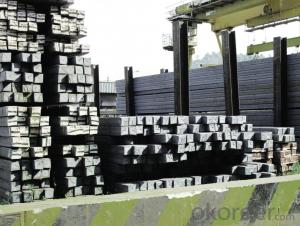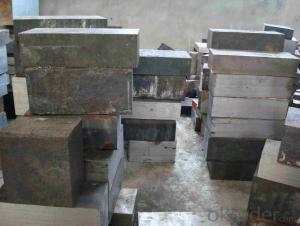Prime quality square alloy steel billet 100mm Q235
- Loading Port:
- Tianjin
- Payment Terms:
- TT OR LC
- Min Order Qty:
- 100 m.t.
- Supply Capability:
- 10000 m.t./month
OKorder Service Pledge
OKorder Financial Service
You Might Also Like
Structure of Prime quality square alloy steel billet 100mm Q235
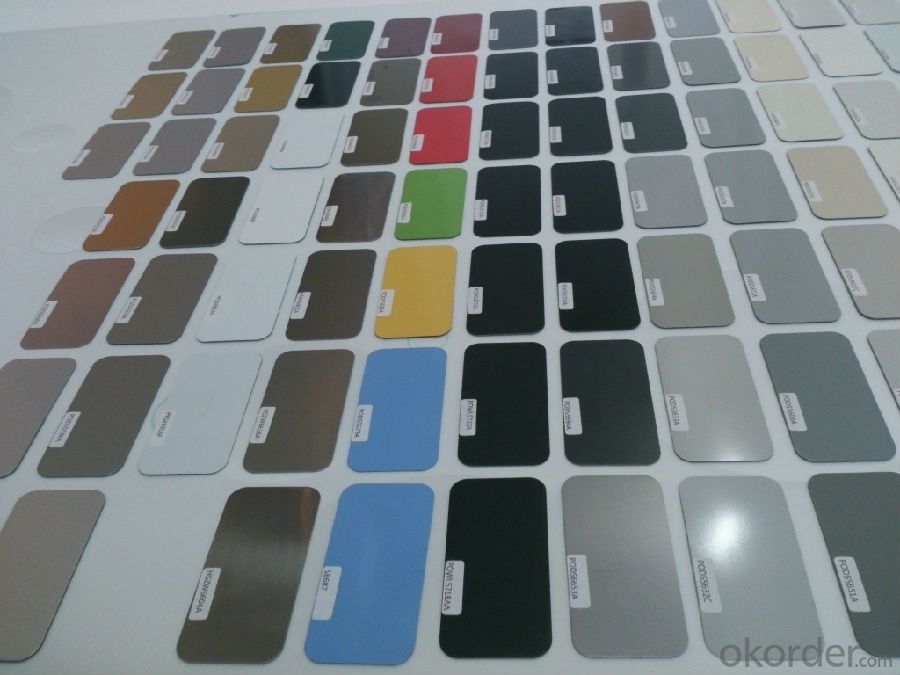
Description of Prime quality square alloy steel billet 100mm Q235
1. Prepainted steel coil is coated with organic layer, which provides higher anti-corrosion property and a longer lifespan than that of galvanized or galvalume steel sheets.
2. The base metals for prepainted steel coil consist of cold rolled, HDGI Steel, electro-galvanized and hot-dip alu-zinc coated steel. The finish coats of prepainted steel coil can be classified into groups as follows: polyester, silicon modified polyesters, polyvinylidene fluoride, high-durability polyester, etc.
3. The production process has evolved from one-coating-and-one-baking to double-coating-and-double-baking, and even three-coating-and-three-baking.
4. The color of the prepainted steel coil has a very wide selection, like orange, cream-colored, dark sky blue, sea blue, bright red, brick red, ivory white, porcelain blue, etc.
5. The prepainted steel coils can also be classified into groups by their surface textures, namely regular prepainted sheets, embossed sheets and printed sheets.

Main Feature of Prime quality square alloy steel billet 100mm Q235
Uncoated CR steel sheet
With the features of in line with the international highest standards in demension and shape, excellent surface finish and properties, the products are mainly used in home appliance and automobile industries.
Galvanized steel sheet(include HDG and EG)
With the features of good corrosion resistance, the products are mainly used in automobile, home appliance, electronics, building and machinery manufacture industries, etc.
Precoated steel sheet
With the features of enviromental protection and good processablility, long lasting surface durability, rich in colors, the products are maily used in building, home appliance and furniture industries, etc.
Applications of Prime quality square alloy steel billet 100mm Q235
Construction
Manufacture anticorrosion, industrial and civil architecture roof boarding, roof grille
Light industries
Home appliance's case, civil chimney, kitchen utensils
Auto industry
Corrosion resistant parts of cars
Agriculture
Food storage, meat and aquatic products' freezing and processing equipment
Commerce
Equipments to store and transport materials, and packing implements

Specifications of Prime quality square alloy steel billet 100mm Q235
Product | Prime quality square alloy steel billet 100mm Q235 |
Material Grade | SGCC / SGCH / DX51D+AZ, etc |
Thickness | 0.6-3.0mm |
Width | 500-1500mm |
Tolerance | Thickness: +/-0.02mm , Width:+/-2mm |
Zinc-coating | Z30-150g/m2 |
Technique | Raw material: Hot rolled steel coil --> Cold rolled_>hot dipped galvalume |
Surface | Dried, Chromated, Unoiled |
Spangle | Regular spangle , small spangle, zero spangle |
ID | 508MM 610MM |
Coil weight | 1-25MT |
Export package | Cardboard inner sleeves, Waterproof paper, galvanized steel covered and steel strip packed |
FAQ of Prime quality square alloy steel billet 100mm Q235
We have organized several common questions for our clients,may help you sincerely:
1. How Can I Visit There?
Our company is located in Tianjin City, China, near Beijing. You can fly to Tianjin Airport Directly. All our clients, from home or aboard, are warmly welcome to visit us!
2. How Can I Get Some Sample?
We are honored to offer you sample.
3. Why choose CNBM?
Our delivery time about 15-20days for standard sizes, if you have other requirements like hardness, quanity and width ,it is about 20-40days. But don't worry we also try our best for the delivery time ,because time longer and our cost is higher.
- Q: How do steel billets contribute to the overall vibration resistance of a product?
- The overall vibration resistance of a product can be significantly enhanced through the use of steel billets. Steel, with its high-strength properties, is an ideal material for reducing vibrations and improving product stability. In the manufacturing process, steel billets are commonly used as a raw material and are further processed into various shapes and forms. Steel billets possess a dense and uniform structure that enables them to effectively absorb and dissipate vibration energy. When integrated into a product, steel billets provide additional mass, which assists in dampening vibrations by absorbing and distributing energy throughout the structure. This added mass acts as a stabilizing force, preventing excessive movement and reducing the amplitude of vibrations. Furthermore, steel billets demonstrate exceptional mechanical properties, including high tensile strength and stiffness, which contribute to a product's overall vibration resistance. These properties allow steel billets to withstand dynamic forces and resist deformation caused by vibrations, ensuring the product's structural integrity. In addition to their superior mechanical properties, steel billets can be designed with specific geometries and cross-sectional shapes to further enhance their vibration resistance. For instance, the use of round or square billets with smooth surfaces minimizes stress concentration points and lowers the risk of fatigue failure. By optimizing the design and dimensions of steel billets, manufacturers can tailor a product's vibration resistance to meet specific requirements. To summarize, steel billets play a critical role in enhancing a product's overall vibration resistance. Their high mass, dense structure, and excellent mechanical properties allow them to effectively absorb and dissipate vibration energy, stabilize the product, and improve its structural integrity. By incorporating steel billets into the manufacturing process, manufacturers can ensure that their products are more resistant to vibrations, leading to enhanced performance and longevity.
- Q: What are the major steel billet producing countries?
- China, India, Russia, Japan, and the United States are the key countries in the production of steel billets. China stands out as the largest producer, responsible for more than half of global output. This dominance can be attributed to its booming steel industry, which has witnessed remarkable growth in recent decades. Following China, India emerges as the second-largest producer, with its steel sector expanding rapidly. Russia, on the other hand, boasts a robust steel industry and ranks third in terms of production. Despite a decline in recent years, Japan still holds significance in the steel billet market. Lastly, the United States contributes significantly to the production of steel billets, focusing particularly on high-quality specialty steel products. These countries play a critical role in meeting the worldwide demand for steel billets, which serve as essential raw materials across various industries, including construction, automotive, and infrastructure.
- Q: How do steel billets contribute to the manufacturing of marine gear?
- Steel billets contribute to the manufacturing of marine gear by serving as the raw material for the production of various components, such as gears, shafts, and bearings. These billets are first heated and then shaped through forging or machining processes to create the desired gear components with high strength and durability. The use of steel billets ensures that the marine gear can withstand the harsh conditions of marine environments, such as corrosion, high loads, and extreme temperatures, ultimately enhancing the performance and reliability of the gear in marine applications.
- Q: What are steel billets?
- Steel billets are semi-finished metal products that are rectangular in shape and usually have a square cross-section. They are produced through a process called casting or continuous casting, where liquid steel is poured into molds and allowed to cool and solidify. Once cooled, the billets are typically hot-rolled or forged to give them their final shape and dimensions. Steel billets serve as a raw material for the production of various steel products, such as bars, rods, wires, and structural sections. They are commonly used in the construction industry for structural purposes, as well as in the manufacturing of automotive parts, pipes, and machinery. The quality of steel billets is crucial, as it directly affects the quality and performance of the final steel products. Therefore, they undergo rigorous quality checks and testing to ensure they meet the required standards for strength, durability, and other mechanical properties. Overall, steel billets play a vital role in the steel industry as a primary raw material for the production of a wide range of steel products, making them an essential component in various sectors of the economy.
- Q: What are the main challenges in the quality control of steel billets?
- Several factors can affect the quality and performance of steel billets, posing significant challenges in their quality control. Here, we outline some key obstacles in this regard: 1. Chemical Composition: The accurate chemical composition of steel billets is pivotal in determining their strength, durability, and mechanical properties. However, ensuring consistent chemical composition is challenging due to variations in raw materials, melting processes, and the presence of impurities. 2. Homogeneity: It is crucial to achieve uniformity in the microstructure and composition throughout the steel billet. Inadequate mixing or non-uniform cooling can lead to inconsistencies, resulting in weak areas and uneven mechanical properties. 3. Defect Detection: Detecting and eliminating defects in steel billets is essential to prevent failures during subsequent processing and usage. Common defects include cracks, inclusions, segregation, porosity, and surface irregularities. However, accurately and promptly detecting these defects can be challenging due to their size, complexity, and location. 4. Dimensional Accuracy: Consistency in the dimensions and shape of steel billets is vital for their further processing and use in various applications. Maintaining precise dimensions requires controlling variables such as casting speed, cooling rates, and mold design. 5. Surface Quality: The condition of the surface of steel billets is critical for subsequent operations like rolling, forging, or machining. Ensuring a smooth, clean, and defect-free surface is challenging due to factors such as scale formation, oxidation, decarburization, and surface contamination during handling and storage. 6. Heat Treatment: Proper heat treatment is often necessary to achieve the desired mechanical properties in steel billets. However, controlling the heating and cooling rates, as well as the soaking times, can be challenging due to variations in equipment, temperature monitoring, and quenching techniques. 7. Traceability: Maintaining traceability and documentation throughout the production process is crucial for quality control. Tracking the origin of raw materials, process parameters, testing records, and certifications can be challenging, especially in complex supply chains. To address these challenges in the quality control of steel billets, a combination of advanced testing techniques, robust process controls, skilled personnel, and continuous improvement initiatives is necessary.
- Q: How are steel billets used in the production of forgings?
- Steel billets are used as the starting material in the production of forgings. They are heated and shaped using specialized machinery and techniques to create the desired shape and size of the final forged product. The billets provide the necessary strength and durability required for forging processes, ensuring the resulting forgings possess the desired mechanical properties.
- Q: How do steel billets contribute to the overall recyclability of a structure?
- Steel billets play a significant role in enhancing the overall recyclability of a structure. These billets, which are semi-finished steel products, are produced by melting iron ore and other raw materials in a blast furnace. Due to their composition and manufacturing process, steel billets possess several characteristics that contribute to the recyclability of a structure. First and foremost, steel is one of the most recycled materials on the planet. Steel billets can be recycled indefinitely without losing their quality or integrity. This means that at the end of a structure's lifespan, the steel components can be easily dismantled and the steel billets can be melted down to produce new steel products. The ability to recycle steel billets reduces the need for extracting and refining new iron ore, which in turn conserves natural resources and minimizes the environmental impact associated with mining activities. Furthermore, the recycling process of steel billets requires significantly less energy compared to the production of steel from raw materials. Recycling steel billets consumes around 75% less energy compared to producing steel from scratch. This energy efficiency not only reduces greenhouse gas emissions but also contributes to cost savings during the manufacturing process. By using recycled steel billets in the construction of structures, we can reduce the carbon footprint and promote sustainable practices in the construction industry. In addition to the environmental benefits, the use of steel billets in structures also offers practical advantages. Steel is known for its strength, durability, and resilience, making it an ideal material for constructing robust and long-lasting structures. By incorporating steel billets, structures can be designed to withstand various environmental conditions, such as earthquakes and hurricanes, ensuring the safety and longevity of the building. This longevity aspect is crucial in terms of recyclability, as it allows the structure to serve its purpose for an extended period before being recycled. In conclusion, steel billets contribute significantly to the overall recyclability of a structure. Their ability to be recycled indefinitely, reduced energy consumption during the recycling process, and practical advantages such as strength and durability make steel billets an excellent choice for constructing sustainable and recyclable structures. By incorporating steel billets, we can promote a circular economy, conserve natural resources, reduce emissions, and create a more sustainable future for construction.
- Q: What is the composition of steel billets?
- Steel billets are solid, semi-finished products that are typically rectangular in shape and are used as raw material in the production of various steel products. The composition of steel billets can vary depending on the specific grade and type of steel being produced. However, in general, steel billets are primarily made up of iron and carbon, with trace amounts of other elements. The main component of steel billets is iron, which typically makes up the majority of the composition. Iron provides the structural strength and durability to the steel. Carbon is another important element present in steel billets, as it enhances the hardness and strength of the steel. The amount of carbon present in the billets determines the type of steel being produced, such as low carbon steel, medium carbon steel, or high carbon steel. In addition to iron and carbon, steel billets also contain small amounts of other elements. These elements may include manganese, silicon, sulfur, phosphorus, and various alloying elements such as chromium, nickel, and molybdenum. These trace elements are added to steel billets to improve specific properties, such as corrosion resistance, toughness, and heat resistance. It is important to note that the composition of steel billets can vary significantly depending on the intended application and specific requirements. Different industries and manufacturers may have their own proprietary blends or specifications for steel billets. Therefore, it is crucial to consult the appropriate standards and specifications to determine the precise composition of steel billets for a given application.
- Q: How are steel billets used in the manufacturing of bars?
- Steel billets are used in the manufacturing of bars by being heated and then rolled or forged into specific shapes and sizes. This process ensures the bars have the desired strength, durability, and dimensional accuracy required for various applications in industries such as construction, automotive, and infrastructure.
- Q: How are steel billets used in the shipbuilding industry?
- Steel billets are used in the shipbuilding industry as a primary raw material for manufacturing various components of a ship's structure, such as hulls, decks, and bulkheads. These billets are melted, cast, and then rolled into the desired shape or size to meet the specific requirements of the ship's design. The high strength and durability of steel make it ideal for withstanding the harsh marine environment and ensuring the structural integrity of the vessel.
Send your message to us
Prime quality square alloy steel billet 100mm Q235
- Loading Port:
- Tianjin
- Payment Terms:
- TT OR LC
- Min Order Qty:
- 100 m.t.
- Supply Capability:
- 10000 m.t./month
OKorder Service Pledge
OKorder Financial Service
Similar products
Hot products
Hot Searches
Related keywords
